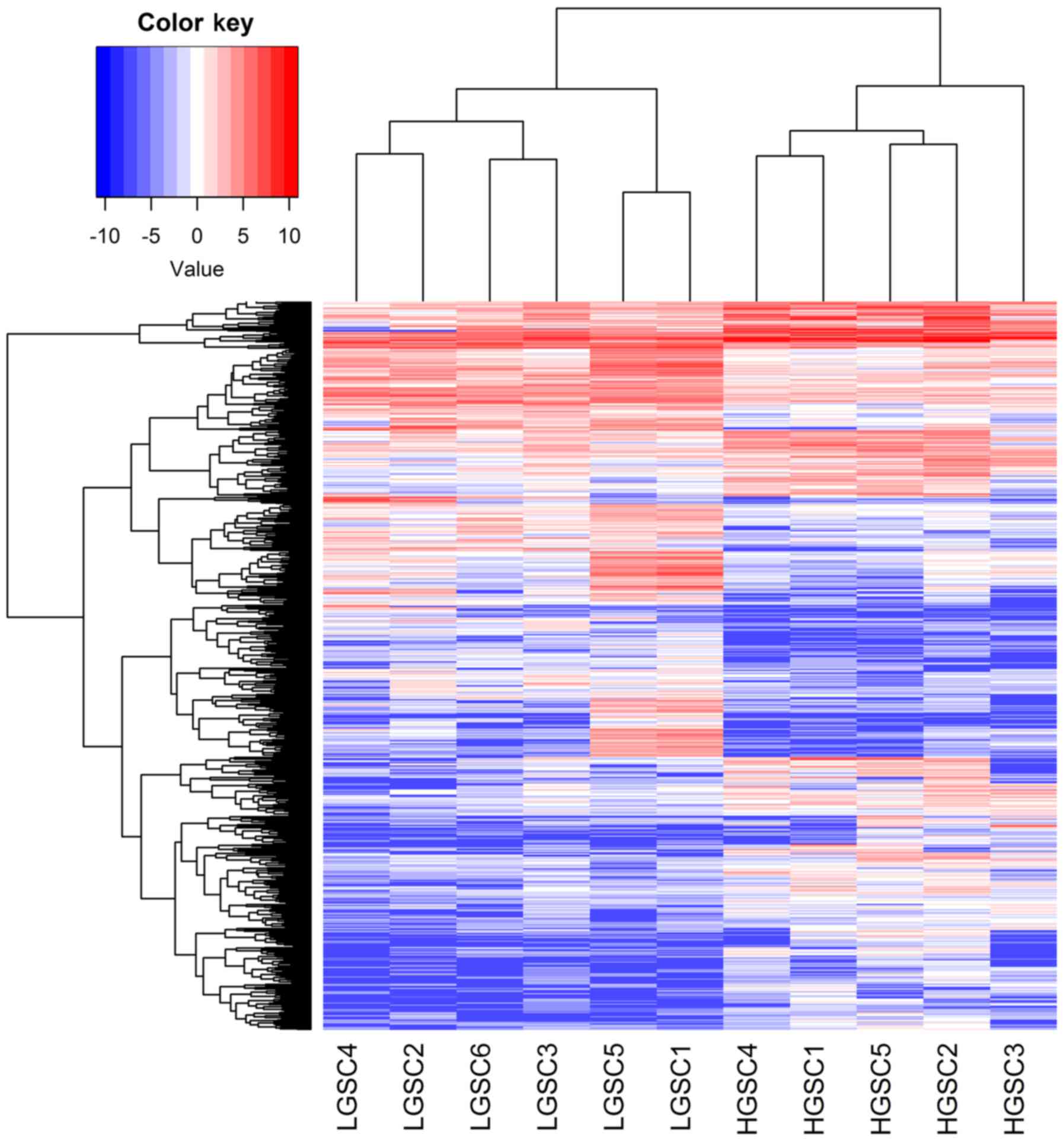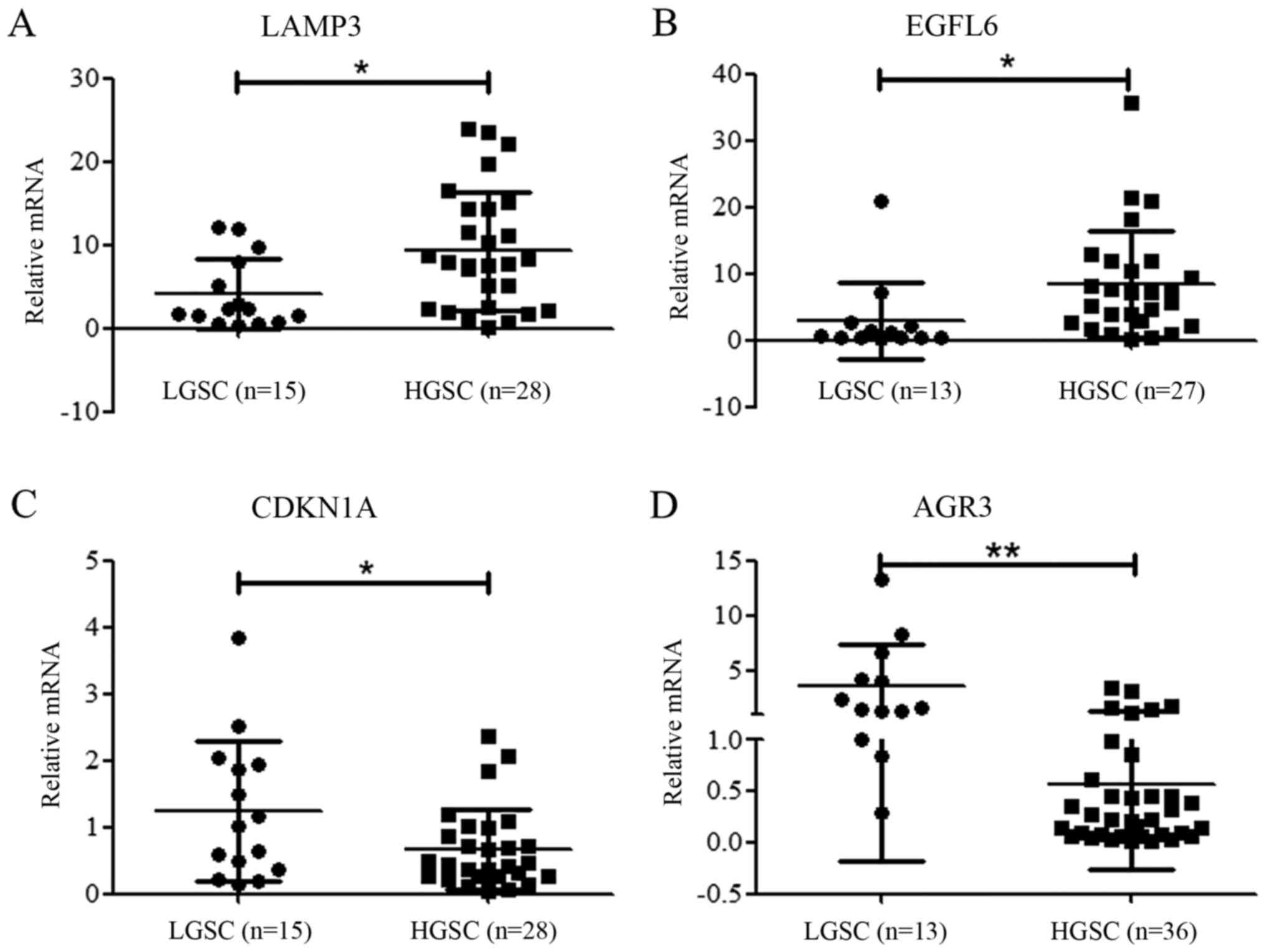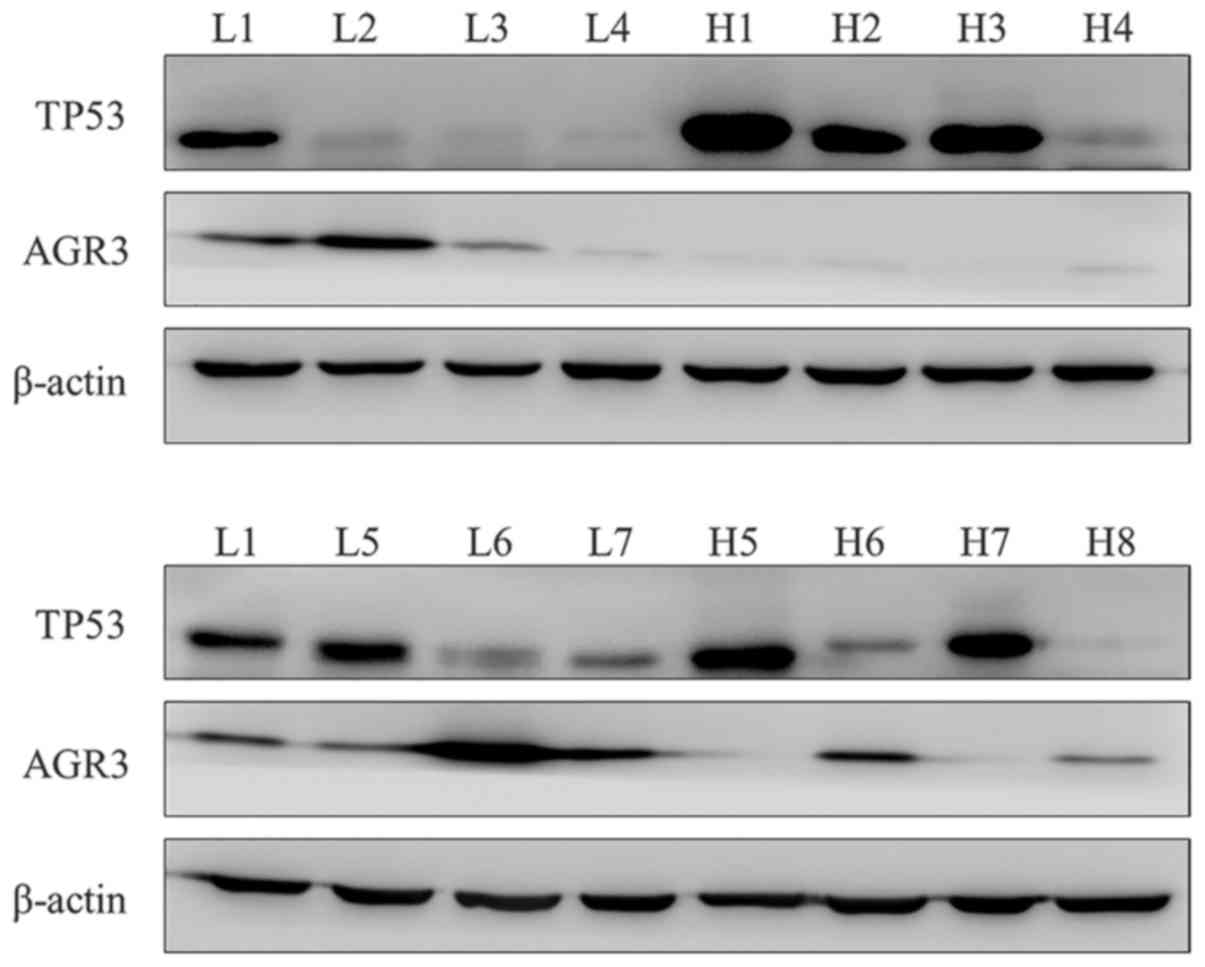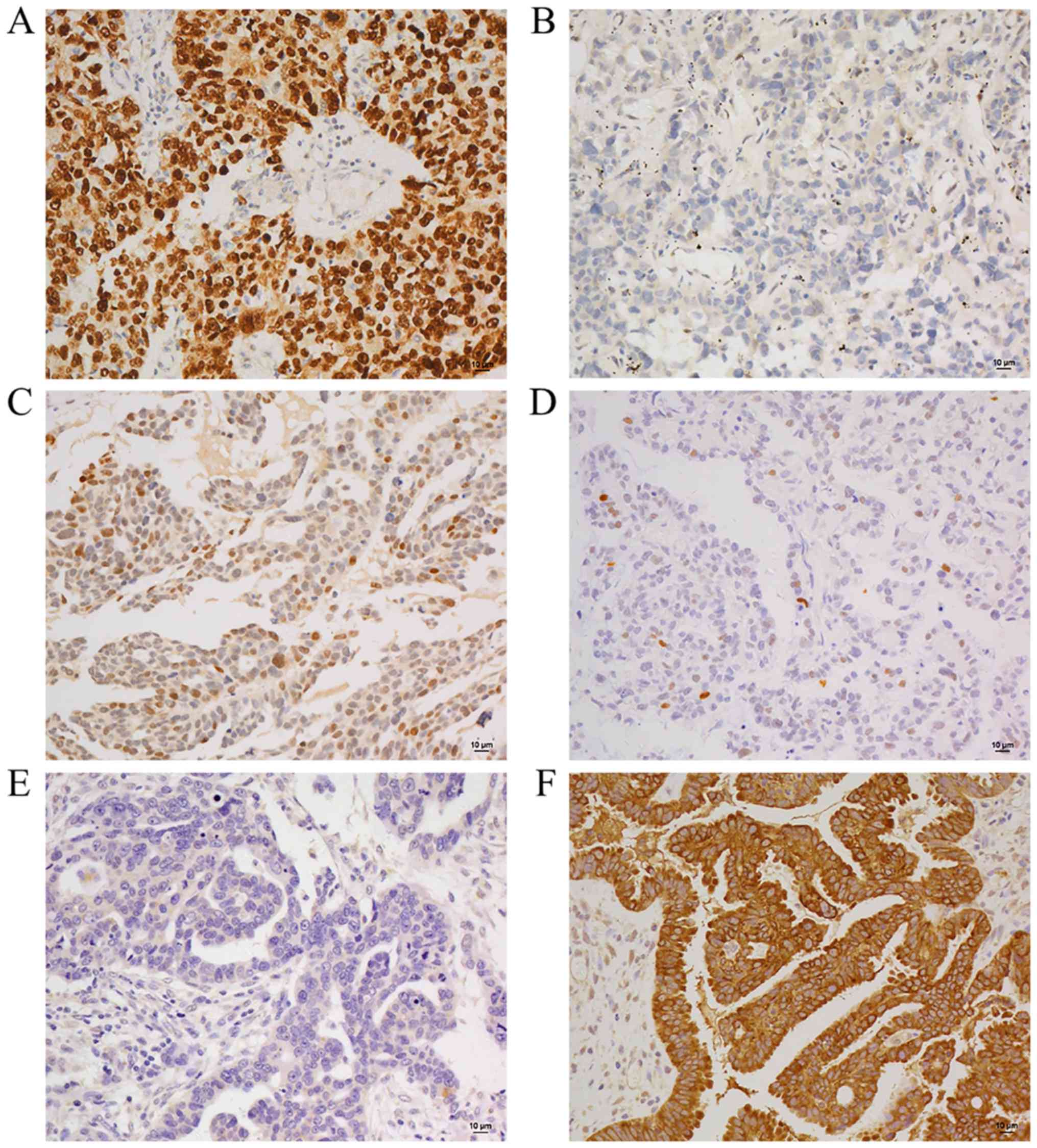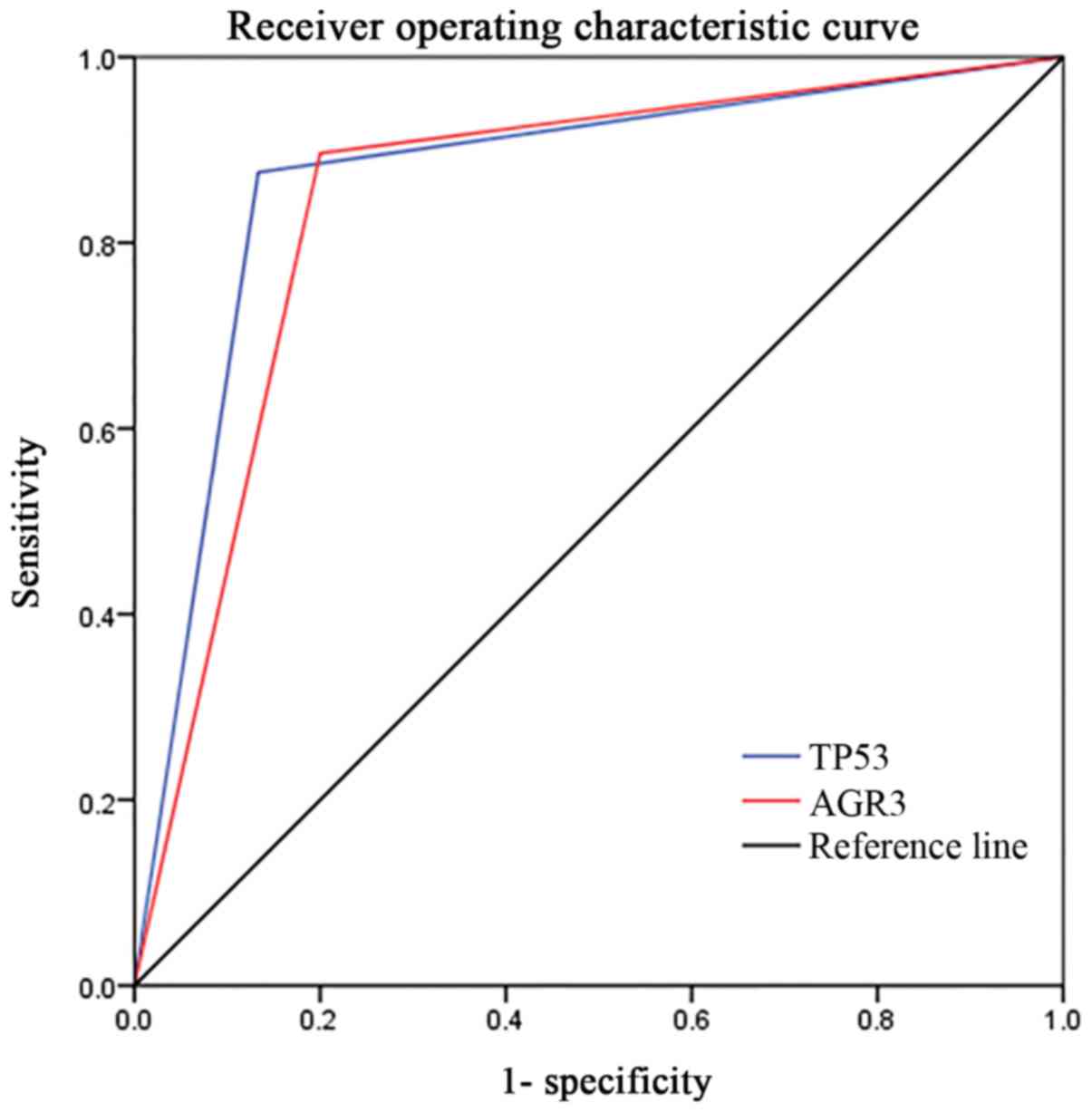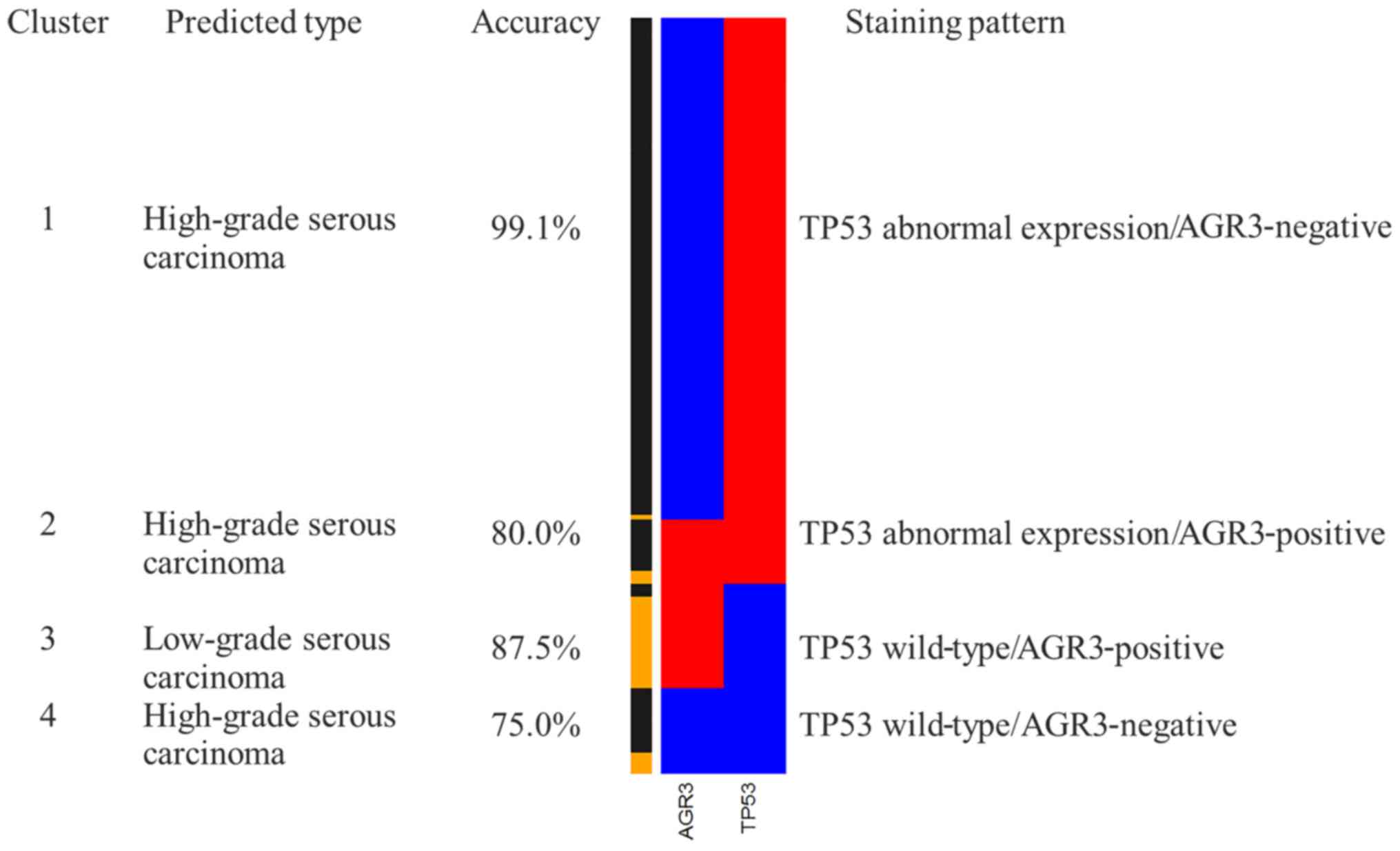|
1
|
Siegel RL, Miller KD and Jemal A: Cancer
Statistics, 2017. CA Cancer J Clin. 67:7–30. 2017. View Article : Google Scholar
|
|
2
|
Prat J: Ovarian carcinomas: Five distinct
diseases with different origins, genetic alterations, and
clinicopathological features. Virchows Archiv. 460:237–249. 2012.
View Article : Google Scholar
|
|
3
|
Köbel M, Kalloger SE, Boyd N, McKinney S,
Mehl E, Palmer C, Leung S, Bowen NJ, Ionescu DN, Rajput A, et al:
Ovarian carcinoma subtypes are different diseases: Implications for
biomarker studies. PLoS Med. 5:e2322008. View Article : Google Scholar
|
|
4
|
Malpica A, Deavers MT, Lu K, Bodurka DC,
Atkinson EN, Gershenson DM and Silva EG: Grading ovarian serous
carcinoma using a two-tier system. Am J Surg Pathol. 28:496–504.
2004. View Article : Google Scholar
|
|
5
|
Bertelsen K, Holund B and Andersen E:
Reproducibility and prognostic value of histologic type and grade
in early epithelial ovarian cancer. Int J Gynecol Cancer. 3:72–79.
1993. View Article : Google Scholar
|
|
6
|
Shimizu Y, Kamoi S, Amada S, Hasumi K,
Akiyama F and Silverberg SG: Toward the development of a universal
grading system for ovarian epithelial carcinoma. I. Prognostic
significance of histopathologic features - problems involved in the
architectural grading system. Gynecol Oncol. 70:2–12. 1998.
View Article : Google Scholar
|
|
7
|
Silverberg SG: Histopathologic grading of
ovarian carcinoma: A review and proposal. Int J Gynecol Pathol.
19:7–15. 2000. View Article : Google Scholar
|
|
8
|
Vang R, Shih IeM and Kurman RJ: Ovarian
low-grade and high-grade serous carcinoma: Pathogenesis,
clinicopathologic and molecular biologic features, and diagnostic
problems. Adv Anat Pathol. 16:267–282. 2009. View Article : Google Scholar
|
|
9
|
Malpica A, Deavers MT, Lu K, Liu J,
Atkinson EN, Gershenson DM and Silva EG: Grading ovarian serous
carcinomas using a two-tier system. Mod Pathol. 15:202a–203a.
2002.
|
|
10
|
Tone AA, Begley H, Sharma M, Murphy J,
Rosen B, Brown TJ and Shaw PA: Gene expression profiles of luteal
phase fallopian tube epithelium from BRCA mutation carriers
resemble high-grade serous carcinoma. Clin Cancer Res.
14:4067–4078. 2008. View Article : Google Scholar
|
|
11
|
Marquez RT, Baggerly KA, Patterson AP, Liu
J, Broaddus R, Frumovitz M, Atkinson EN, Smith DI, Hartmann L,
Fishman D, et al: Patterns of gene expression in different
histotypes of epithelial ovarian cancer correlate with those in
normal fallopian tube, endometrium, and colon. Clin Cancer Res.
11:6116–6126. 2005. View Article : Google Scholar
|
|
12
|
Li J, Abushahin N, Pang S, Xiang L,
Chambers SK, Fadare O, Kong B and Zheng W: Tubal origin of
‘ovarian’ low-grade serous carcinoma. Mod Pathol. 24:1488–1499.
2011. View Article : Google Scholar
|
|
13
|
Qiu C, Lu N, Wang X, Zhang Q, Yuan C, Yan
S, Dongol S, Li Y, Sun X, Sun C, et al: Gene expression profiles of
ovarian low-grade serous carcinoma resemble those of fallopian tube
epithelium. Gynecol Oncol. 147:634–641. 2017. View Article : Google Scholar
|
|
14
|
May T, Shoni M, Crum CP, Xian W,
Vathipadiekal V, Birrer M, Rosen B, Tone A and Murphy KJ: Low-grade
and high-grade serous Mullerian carcinoma: Review and analysis of
publicly available gene expression profiles. Gynecol Oncol.
128:488–492. 2013. View Article : Google Scholar
|
|
15
|
Vergote I, Tropé CG, Amant F, Kristensen
GB, Ehlen T, Johnson N, Verheijen RHM, van der Burg MEL, Lacave AJ,
Panici PB, et al European Organization for Research and Treatment
of Cancer-Gynaecological Cancer Group; NCIC Clinical Trials Group:
Neoadjuvant chemotherapy or primary surgery in stage IIIC or IV
ovarian cancer. N Engl J Med. 363:943–953. 2010. View Article : Google Scholar
|
|
16
|
Pohl G, Ho CL, Kurman RJ, Bristow R, Wang
TL and Shih IeM: Inactivation of the mitogen-activated protein
kinase pathway as a potential target-based therapy in ovarian
serous tumors with KRAS or BRAF mutations. Cancer Res.
65:1994–2000. 2005. View Article : Google Scholar
|
|
17
|
Malpica A, Deavers MT, Tornos C, Kurman
RJ, Soslow R, Seidman JD, Munsell MF, Gaertner E, Frishberg D and
Silva EG: Interobserver and intraobserver variability of a two-tier
system for grading ovarian serous carcinoma. Am J Surg Pathol.
31:1168–1174. 2007. View Article : Google Scholar
|
|
18
|
Ayhan A, Kurman RJ, Yemelyanova A, Vang R,
Logani S, Seidman JD and Shih IeM: Defining the cut point between
low-grade and high-grade ovarian serous carcinomas: A
clinico-pathologic and molecular genetic analysis. Am J Surg
Pathol. 33:1220–1224. 2009. View Article : Google Scholar
|
|
19
|
Kalloger SE, Köbel M, Leung S, Mehl E, Gao
D, Marcon KM, Chow C, Clarke BA, Huntsman DG and Gilks CB:
Calculator for ovarian carcinoma subtype prediction. Mod Pathol.
24:512–521. 2011. View Article : Google Scholar
|
|
20
|
Kim D, Pertea G, Trapnell C, Pimentel H,
Kelley R and Salzberg SL: TopHat2: Accurate alignment of
transcriptomes in the presence of insertions, deletions and gene
fusions. Genome Biol. 14:R362013. View Article : Google Scholar
|
|
21
|
Mortazavi A, Williams BA, McCue K,
Schaeffer L and Wold B: Mapping and quantifying mammalian
transcriptomes by RNA-Seq. Nat Methods. 5:621–628. 2008. View Article : Google Scholar
|
|
22
|
O’Neill CJ, Deavers MT, Malpica A, Foster
H and McCluggage WG: An immunohistochemical comparison between
low-grade and high-grade ovarian serous carcinomas: Significantly
higher expression of p53, MIB1, BCL2, HER-2/neu, and C-KIT in
high-grade neoplasms. Am J Surg Pathol. 29:1034–1041. 2005.
|
|
23
|
Yemelyanova A, Vang R, Kshirsagar M, Lu D,
Marks MA, Shih IeM and Kurman RJ: Immunohistochemical staining
patterns of p53 can serve as a surrogate marker for TP53 mutations
in ovarian carcinoma: An immunohistochemical and nucleotide
sequencing analysis. Mod Pathol. 24:1248–1253. 2011. View Article : Google Scholar
|
|
24
|
Cole AJ, Dwight T, Gill AJ, Dickson KA,
Zhu Y, Clarkson A, Gard GB, Maidens J, Valmadre S, Clifton-Bligh R,
et al: Assessing mutant p53 in primary high-grade serous ovarian
cancer using immunohistochemistry and massively parallel
sequencing. Sci Rep. 6:261912016. View Article : Google Scholar
|
|
25
|
Altman AD, Nelson GS, Ghatage P, McIntyre
JB, Capper D, Chu P, Nation JG, Karnezis AN, Han G, Kalloger SE, et
al: The diagnostic utility of TP53 and CDKN2A to distinguish
ovarian high-grade serous carcinoma from low-grade serous ovarian
tumors. Mod Pathol. 26:1255–1263. 2013. View Article : Google Scholar
|
|
26
|
King ER, Tung CS, Tsang YTM, Zu Z, Lok
GTM, Deavers MT, Malpica A, Wolf JK, Lu KH, Birrer MJ, et al: The
anterior gradient homolog 3 (AGR3) gene is associated with
differentiation and survival in ovarian cancer. Am J Surg Pathol.
35:904–912. 2011. View Article : Google Scholar
|
|
27
|
Vang R, Shih IeM and Kurman RJ: Fallopian
tube precursors of ovarian low- and high-grade serous neoplasms.
Histopathology. 62:44–58. 2013. View Article : Google Scholar
|
|
28
|
Bell D, Berchuck A, Birrer M, Chien J,
Cramer DW, Dao F, Dhir R, DiSaia P, Gabra H, Glenn P, et al Cancer
Genome Atlas Research Network: Integrated genomic analyses of
ovarian carcinoma. Nature. 474:609–615. 2011. View Article : Google Scholar
|
|
29
|
Smith Sehdev AE, Sehdev PS and Kurman RJ:
Noninvasive and invasive micropapillary (low-grade) serous
carcinoma of the ovary: A clinicopathologic analysis of 135 cases.
Am J Surg Pathol. 27:725–736. 2003. View Article : Google Scholar
|
|
30
|
Bell DA, Longacre TA, Prat J, Kohn EC,
Soslow RA, Ellenson LH, Malpica A, Stoler MH and Kurman RJ: Serous
borderline (low malignant potential, atypical proliferative)
ovarian tumors: Workshop perspectives. Hum Pathol. 35:934–948.
2004. View Article : Google Scholar
|
|
31
|
Longacre TA, McKenney JK, Tazelaar HD,
Kempson RL and Hendrickson MR: Ovarian serous tumors of low
malignant potential (borderline tumors): Outcome-based study of 276
patients with long-term (> or =5-year) follow-up. Am J Surg
Pathol. 29:707–723. 2005. View Article : Google Scholar
|
|
32
|
O’Neill CJ, McBride HA, Connolly LE,
Deavers MT, Malpica A and McCluggage WG: High-grade ovarian serous
carcinoma exhibits significantly higher p16 expression than
low-grade serous carcinoma and serous borderline tumour.
Histopathology. 50:773–779. 2007. View Article : Google Scholar
|
|
33
|
Vang R, Levine DA, Soslow RA, Zaloudek C,
Shih IeM and Kurman RJ: Molecular alterations of TP53 are a
defining feature of ovarian high-grade serous carcinoma: A rereview
of cases lacking TP53 mutations in the Cancer Genome Atlas Ovarian
Study. Int J Gynecol Pathol. 35:48–55. 2016. View Article : Google Scholar
|
|
34
|
Sundov D, Caric A, Mrklic I, Gugic D,
Capkun V, Hofman ID, Mise BP and Tomic S: P53, MAPK, topoisomerase
II alpha and Ki67 immunohistochemical expression and KRAS/BRAF
mutation in ovarian serous carcinomas. Diagn Pathol. 8:212013.
View Article : Google Scholar
|
|
35
|
Singer G, Stöhr R, Cope L, Dehari R,
Hartmann A, Cao DF, Wang TL, Kurman RJ and Shih IeM: Patterns of
p53 mutations separate ovarian serous borderline tumors and low-
and high-grade carcinomas and provide support for a new model of
ovarian carcinogenesis: A mutational analysis with
immunohistochemical correlation. Am J Surg Pathol. 29:218–224.
2005. View Article : Google Scholar
|















